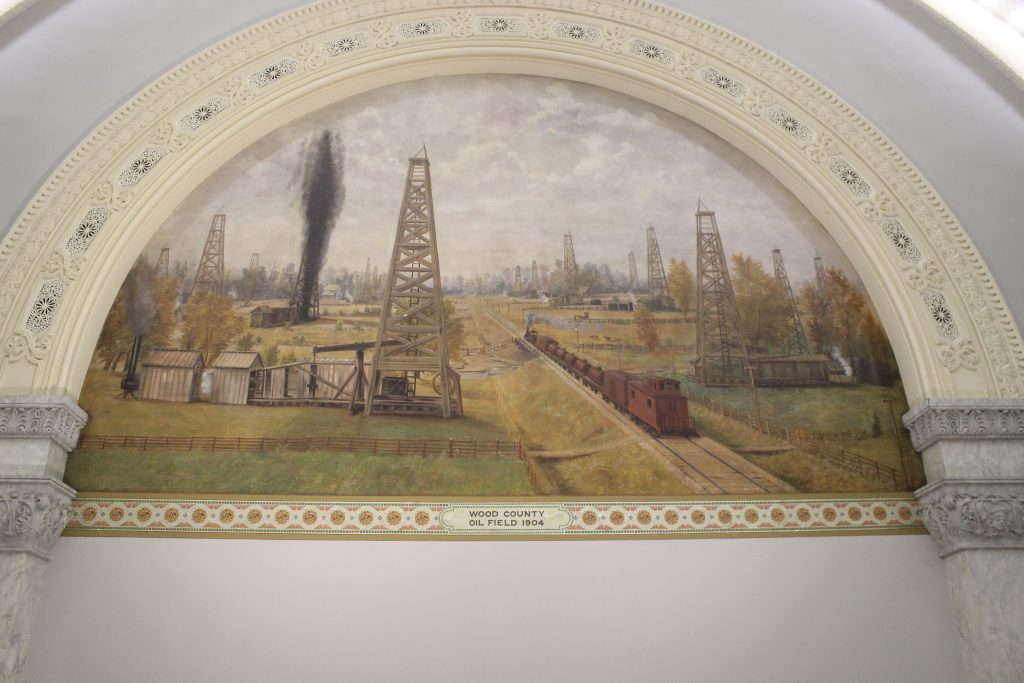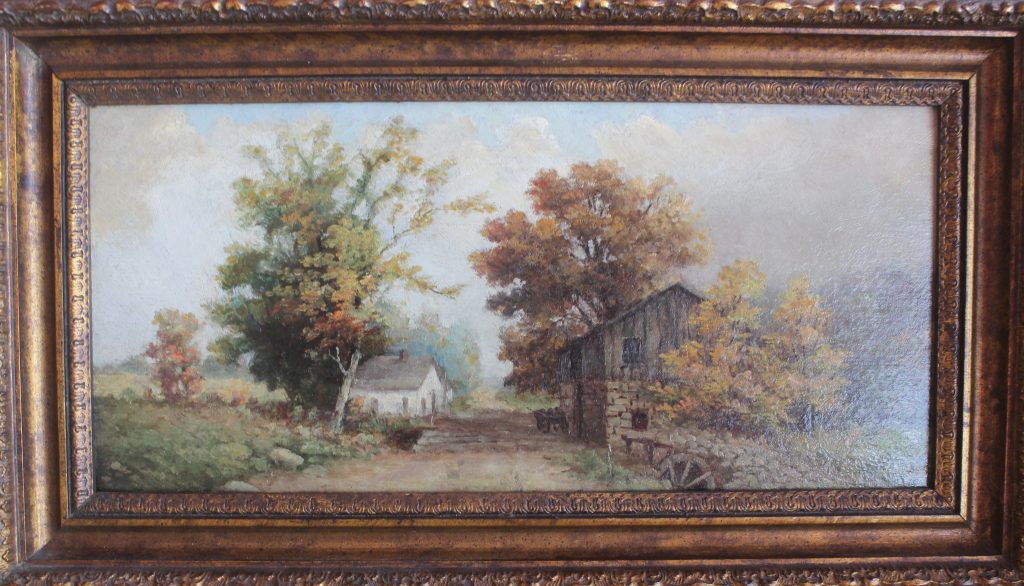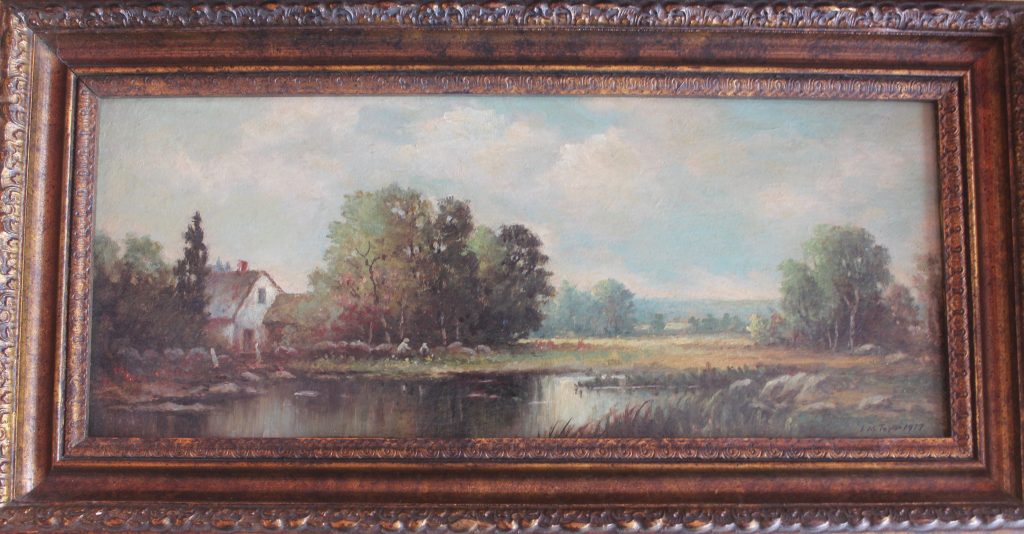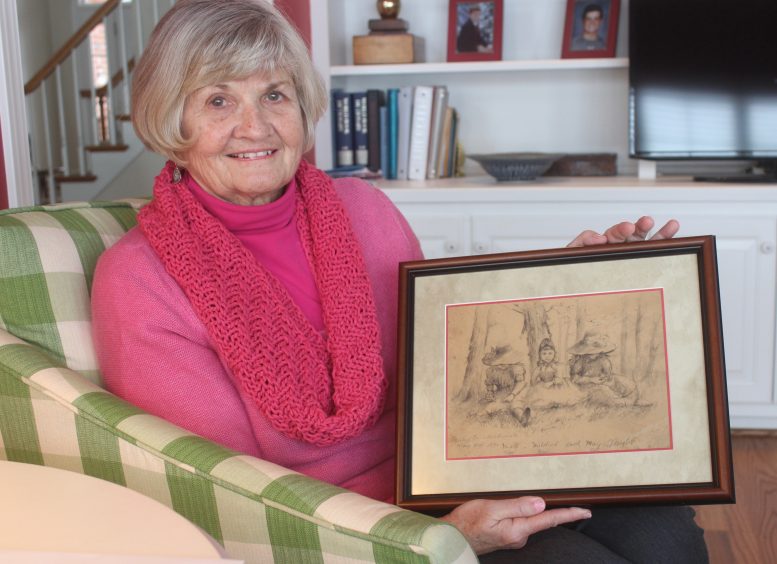By DAVID DUPONT
BG Independent News
The murals on the second floor of the Wood County Courthouse are public treasures.
For Cheryl Windisch, of Bowling Green, they are family history.
The murals that are undergoing preservation work were painted by her great-grandfather Isaac Moore Taylor.

Taylor, who was born 175 years ago on Feb. 5, 1844 in western New York close by the Pennsylvania oil fields, was an oil man drawn in middle age to Wood County, where he got involved in local politics, including a single term as mayor of Bowling Green.
But his passion was painting.
“He loved doing that more than he enjoyed having real jobs,” his great-granddaughter said. “He was really kind of a wanderlust guy.”
That wanderlust took him out west on oil business, before he settled in Bowling Green where he and his wife, Adella, raised their four daughters, including Windisch’s grandmother Mildred.
His interest in art started when he was a child, and he studied with two master teachers in his youth.
When he was 15 the Drake oil strike in Oil Creek, Pennsylvania, occurred, and that sparked his interest in the oil business. He became a leading authority whose advice was sought nationwide, according to a biographical sketch written by the family.
The first Ohio well he drilled was in what is now the middle of Findlay. Then he started to explore in the Sand Ridge area of Bowling Green.
All the while, his great-granddaughter said, he continued painting.
His family settled in town in a home at 249 S. Church St. The house is still standing. The place where he painted, an old barn in the rear, was torn down when the post office was expanded and the drive-through added.
That “paint shop,” both Windsich and her brother Scott Cunningham, the family historian, recall, was mostly off-limits for children. Their mother was allowed in a few times.
“Usually kids weren’t allowed to go in there because there was too much stuff for them to get into,” Windisch said.
Taylor created art in a variety styles and for a variety reasons.
He did designs for business signs. He painted pictures with calendars attached as Christmas presents for his grandchildren. And he used whatever material scraps of paper, bed ticking, cardboard, and door panels was at hand.
But he also did finely executed drawings and oil paintings including landscapes and portraits. Windisch said he created a large portrait of his parents. A Washington D.C. curator once told her aunt that the painting was worthy of the Smithsonian. And one of his last works was a large scale painting of the Drake oil well that first captured his imagination.
Windisch owns two landscapes one in spring and one in fall. Other paintings are spread among family and friends.


In 1983, in conjunction with the city’s sesquicentennial celebrations, the family put together an exhibit of Taylor’s work that was displayed in McFall Center at Bowling Green State University. Windisch said she recalls collectors insisting that they get their paintings back.
Taylor’s most notable work, though, are the courthouse murals. One depicts Fort Meigs in 1813, and the other shows the oil fields in the early 20th century.
Windisch said that once at another sesquicentennial event, someone approached her mother and said that Taylor had not painted the mural. Harriet Cunningham was upset by that notion.
Taylor didn’t sign the murals, nor much, if any, of his other work.
Someone who attempted a restoration of the murals about 40 years ago did sign his work. That’s ironic given that Stefan Dedecek, the art conservator working on the murals, said much of his work now is undoing what was done earlier. “Somebody worked on it before me, and that’s the worst thing.”
But the controversy over who painted the murals was short-lived, Windisch said. “It was settled.” They are the work of I.M. Tayor.
One mystery remains unsolved. When were the murals painted? Mike Sibbersen, former county auditor and local history devotee, has searched for an answer.
One date that’s been posited in 1910-1911, but that seems to be conflated with when Taylor was mayor of the city.
Sibbersen has searched county records hoping to find a contract, but to no avail. The one hint is that the mural depicting the oil field says it is a view from 1904. If the local newspaper becomes digitized that may offer clues.
Windisch said the family has no records of when Taylor may have painted the murals.
The question may be as enduring as the art that his family still treasures.

